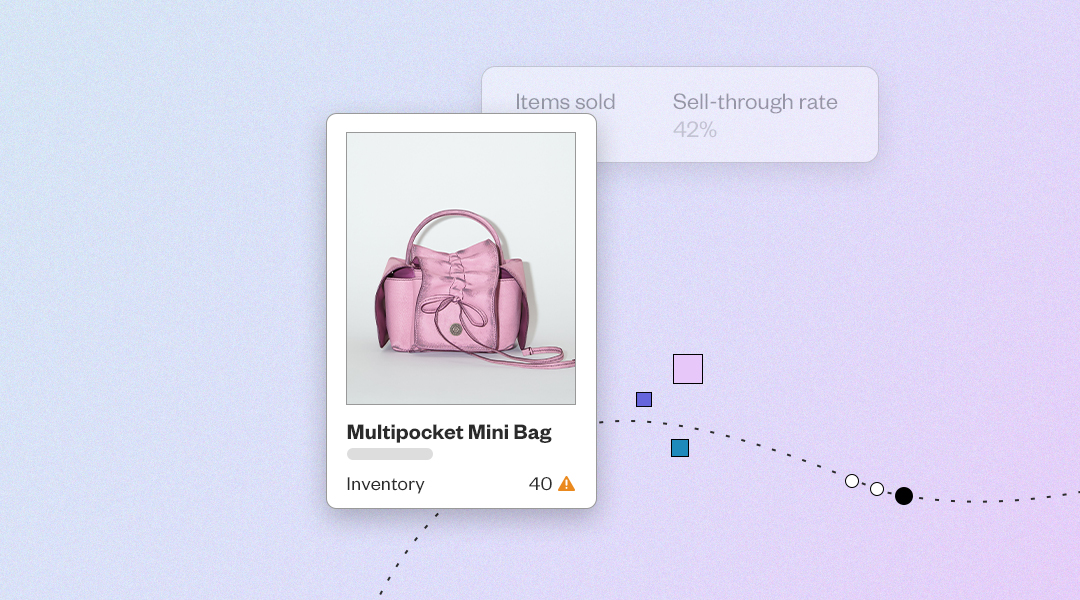What is eCommerce inventory management?
Discover what ecommerce inventory management is and why NuORDER can help you keep everything in perfect order.
.jpg)
One of the trickiest parts of running an ecommerce business is inventory management. Finding the perfect mix of enough stock to meet demands without unnecessary overstocking is a tough balancing act that, if not managed well, can lead to wasted inventory and unnecessary storage expenses. In this blog post, we'll explore how to approach ecommerce inventory management and find the right balance for your ecommerce business. We'll also explore some tips and tricks on finding software to help simplify your ecommerce inventory management.
What is eCommerce Inventory Management?
eCommerce inventory management is all about managing available product inventory you have prepared to ship to customers without racking up unnecessary costs by overstocking. It involves closely monitoring stock levels, tracking product movements, and planning ahead to ensure you have the right amount of products available when you need them.
Why eCommerce Inventory Management is Important
If your eCommerce inventory management is going well, it should occur mostly behind the scenes of your business operations. However, this doesn’t mean you should push inventory management efforts to the back burner. Inventory management helps you maintain the delicate balance of stock by ensuring you have products in stock to meet demands in a timely manner to satisfy customers and prevent you from overstocking, which can tie up your money and warehouse space. When you get the inventory management balance right, you can optimize your cash flow, boost profitability, and keep your business running smoothly. Inventory management directly impacts almost all the elements of your business operation — from customer satisfaction to process efficiency. Investment in improving your eCommerce inventory management can optimize and improve all aspects of your operations and keep your customers happy.
eCommerce Inventory Management Methods

A wide variety of methods are used to manage, organize, and maintain their inventory. We outline a few common ways businesses approach their eCommerce inventory management. Keep in mind that multiple of these methods may be used in one process.
Methods of Procuring and Maintaining Inventory
Just In Time (JIT) Inventory
Just In Time (JIT) inventory management means getting products just when you need them, without keeping excess stock. JIT management requires you to synchronize your supply with the demand so that you can strategically reduce inventory levels, minimize storage costs, and improve your overall operational efficiency.
Par Level Inventory
Often, eCommerce businesses will set par levels (or required minimum amount of stock) that will always be maintained. This means that when inventory levels fall below the set amount, inventory will be ordered to bring it back to the minimum. The amount of stock identified as par level typically includes the expected weekly usage (or expected monthly/other usage, depending on procurement schedules) plus a safety stock (which we’ll discuss more later). This simplifies the inventory management process, making it feasible for any employee to order additional required products.
Inventory Turnover: First In, First Out (FIFO) Inventory
Have you ever heard the saying "first come, first served"? First in, first out (FIFO) inventory management follows a similar principle. It means you sell your oldest inventory first to ensure your products stay fresh and avoid waste. This approach is most often used when dealing with perishable or time-sensitive items. FIFO management ensures you maintain product quality and minimize the risk of holding onto expired or outdated inventory.
Outsourcing Inventory Management: Dropshipping

Depending on the size of your company and the volume and throughput of products you handle, it can be helpful to consider dropshipping. Dropshipping is basically outsourcing your inventory management to your suppliers. Instead of shipping products from your shipping center when a customer places an order, dropshipped products are shipped directly to the customer from the supplier or manufacturer, saving you the hassle of storing and managing inventory. It's a popular option for those who want to focus more on marketing and customer service as opposed to delivery logistics.
Best Practices for eCommerce Inventory Management
There are a variety of approaches and best practices to managing your ecommerce inventory effectively. We’ll review some key inventory management ideas to help you build a sustainable, optimized management strategy.
Keep Safety Stock
Imagine you’re prepared to fulfill your usual amount of customer orders, and you’ve prepared your stock accordingly. If there's an unexpected surge in demand or your supplier experiences delays, you will suddenly struggle to keep up with your orders. To avoid this scenario, you always want to keep safety stock — additional stock you don’t anticipate using — on hand. This stock acts as a buffer against unexpected spikes in demand or supply chain disruptions so you can avoid stock outs and ensure that you can continue filling orders even during challenging times.
Balance Your Inventory

While you always want to maintain enough stock to meet your demands and keep safety stock for any unexpected events, you don’t want to go overboard. This balance requires analyzing demand patterns, adjusting reorder points, and finding the balance where you have sufficient inventory without unnecessarily using capital or warehouse space.
Use Sales & Bundles Effectively
You can utilize discount sales, promotions, and kitting (where you bundle 2 products together, like in buy-one-get-one promotions) to profitably move overstocked product while building your relationship with customers. Looking for some extra insight on how to do this? Learn about NuORDER by Lightspeed’s promotion management tools.
Use Past Orders to Predict Future Stock
One way to anticipate your demand and maintain the right amount of inventory is to use historical data on customers' preferences and buying patterns. This data can help you identify popular products, spot slow-moving items, and anticipate seasonal trends. With this data in your back pocket, you can optimize your inventory levels for times of the year and buying patterns, fine-tune your procurement strategies to account for demand changes, and allocate your resources more effectively. Using these data insights lets you take a proactive approach to your inventory management and plan for the future in the face of uncertainty.
Use Storage Wisely
If you had unlimited resources and storage space, you could purchase and store unlimited amounts of stock, so no matter what happens in your ecommerce future, you would be prepared to fulfill customer orders and wouldn’t worry about overspending without a return. However, we’re willing to bet that your ecommerce business (unfortunately) doesn’t have unlimited resources or storage space. This means that you have to carefully plan when you make purchases and how much product you can store. One thing you might forget to consider is how you store your product. An organized warehouse can store more stock and streamline processes. When setting up your storage facility, group similar products together and utilize labeling and categorization systems like barcodes or RFIDs. Optimizing your warehouse capacity will improve order fulfillment efficiency and keep your inventory operations running smoothly.
Use an eCommerce Inventory Management Software

After reading this, you might feel overwhelmed by the prospect of creating or optimizing your inventory management processes. However, a variety of inventory management software systems can automate, streamline, and simplify your past data, decision-making, and real-time management in ways that will help your business grow without increasing stress. Look for a software solution that offers inventory tracking, data insights & tracking, order management, demand forecasting, and reporting capabilities.
For extra power, partner an inventory management software with an eCommerce software like NuORDER by Lightspeed. NuORDER by Lightspeed lets you manage which products your customers see and how they see them with customizable linesheets and 3D product views. Plus, EZ-Orders lets customers shop, purchase, and reorder through emails, while assortment planning tools help you choose the best products to purchase and feature. All these features are tied up in a bow with easy-to-read dashboards that will help you gain data on sales processes, trends, and buying patterns that, combined with data from your inventory management software, will allow you to make informed, strategic inventory management decisions.
Conclusion
Effective inventory management is a game-changer in the fast-paced world of eCommerce. By implementing the right strategies and utilizing software solutions, you can optimize your operations, reduce costs, and meet customer demands with no sweat. Whether you're balancing stock levels, forecasting future needs, or making the most of your warehouse space, mastering eCommerce inventory management will set you up for success in the competitive online marketplace.
Learn how NuORDER can jumpstart your eCommerce inventory management. Click below to request a demo.
Related articles
Get on the list
Wholesale tips and industry news you can’t miss, delivered weekly
